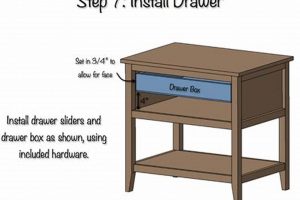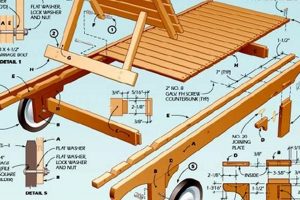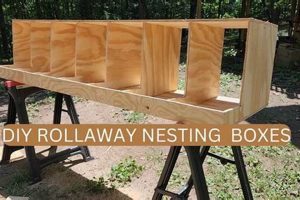Detailed instructions for constructing seating furniture from readily available materials constitute a category of guides designed for the amateur craftsman. These schematics frequently incorporate lumber, textiles, and fasteners, providing step-by-step processes to create customized sofas. Examples include designs using pallet wood, repurposed frames, or entirely new constructions.
The inherent value of these guides resides in the potential for cost savings and customization. Individuals can tailor the size, style, and fabric choices to match specific aesthetic preferences and spatial constraints. Historically, self-sufficiency in furniture construction was a common practice, and this category of guides represents a contemporary resurgence of that principle, adapted for modern resources and design sensibilities.
The subsequent sections will elaborate on material selection criteria, essential tools and techniques, common design variations, and considerations for long-term durability. Understanding these elements will empower the constructor to navigate the complexities of self-built furniture projects successfully.
Essential Considerations for Self-Constructed Seating
Careful planning and execution are crucial for successful seating furniture construction. The following guidelines provide essential insights for optimal results.
Tip 1: Material Selection: Prioritize hardwoods like oak or maple for structural components due to their superior strength and stability compared to softwoods. Ensure lumber is kiln-dried to minimize warping or cracking.
Tip 2: Accurate Measurements: Double-check all measurements before cutting materials. Inaccurate dimensions can lead to structural instability and aesthetic imperfections. Employ a precise measuring tape and a carpenter’s square.
Tip 3: Robust Joinery: Utilize strong joinery techniques such as mortise and tenon, dovetail, or pocket hole joinery for maximum structural integrity. Avoid relying solely on screws or nails for load-bearing connections.
Tip 4: Fabric Selection: Choose durable, tightly woven fabrics resistant to abrasion and fading. Consider stain-resistant treatments to prolong the lifespan of the upholstery. Heavy-duty canvas or upholstery-grade microfiber are viable options.
Tip 5: Cushion Density: Select high-density foam for seat cushions to provide adequate support and prevent premature sagging. Test the firmness of the foam by applying pressure and observing its recovery rate.
Tip 6: Ergonomic Design: Incorporate ergonomic principles into the design to ensure comfortable seating posture. Consider seat height, backrest angle, and lumbar support. Conduct test sittings throughout the construction process.
Tip 7: Secure Fastenings: Use high-quality screws and bolts with appropriate thread length and diameter for secure connections. Pre-drill pilot holes to prevent wood splitting, particularly when working with hardwoods.
Adherence to these guidelines will contribute significantly to the creation of durable, comfortable, and aesthetically pleasing seating furniture. The longevity and usability of the finished product depend on meticulous attention to detail.
The final section will address finishing techniques and maintenance recommendations to ensure lasting beauty and functionality.
1. Frame Durability
Frame durability directly impacts the lifespan and structural integrity of furniture created from these guides. A robust frame ensures the seating can withstand regular use and weight-bearing demands without collapsing or exhibiting signs of structural failure. Material selection is a primary determinant of frame durability; hardwoods such as oak, maple, or birch are preferable to softwoods like pine or fir due to their inherent strength and resistance to wear. For example, a frame constructed from kiln-dried oak, joined with mortise-and-tenon joints, will demonstrably outperform a frame built from untreated pine secured with screws in terms of load-bearing capacity and resistance to warping or cracking over time.
Furthermore, proper joinery techniques contribute significantly to frame robustness. Employing methods like dovetail joints, mortise-and-tenon joints, or reinforced corner blocks distributes stress more effectively than relying solely on screws or nails. The consequence of neglecting frame durability can manifest as sagging cushions, wobbly legs, or complete structural failure, rendering the seating unusable and potentially hazardous. Adhering to design specifications and material recommendations outlined in quality construction guides is crucial for achieving a durable frame.
In summary, frame durability is a foundational element for successful construction of seating furniture. Choosing appropriate materials, implementing sound joinery techniques, and adhering to established design principles are essential to ensure the longevity and safety of the finished product. Failure to prioritize frame durability undermines the entire construction effort, resulting in a product that is both aesthetically unappealing and functionally inadequate.
2. Upholstery Choice
The selection of upholstery fabric represents a critical decision point in the execution of self-constructed seating projects. It directly impacts the aesthetic appeal, durability, comfort, and maintainability of the finished piece. The chosen material is more than a surface covering; it is an integral component that influences the overall success of the project.
- Aesthetic Compatibility
The selected fabric must harmonize with the intended design aesthetic. The color, texture, and pattern contribute significantly to the visual impact. For instance, a mid-century modern design might necessitate a tightly woven, solid-colored fabric, while a more bohemian aesthetic may accommodate patterned textiles with varying textures. The incorrect fabric choice can detract from the overall design, resulting in a visually discordant outcome. Consider existing decor elements when choosing a material.
- Durability and Wear Resistance
The fabric’s ability to withstand daily wear and tear is paramount. Considerations include abrasion resistance, tear strength, and resistance to fading. Fabrics intended for high-traffic areas require a higher Martindale rub count, indicating superior resistance to abrasion. Pet owners, for example, should prioritize tightly woven fabrics to minimize snagging and damage from claws. The durability of the fabric determines the longevity of the upholstered seating.
- Comfort and Tactile Properties
The tactile feel of the fabric directly influences the seating experience. Factors such as breathability, softness, and temperature regulation contribute to overall comfort. Natural fibers like cotton and linen offer breathability but may lack durability, while synthetic fibers like microfiber offer increased durability but may retain heat. The ideal choice balances comfort with practicality, considering the intended use and environmental conditions.
- Maintenance and Cleanability
The ease of cleaning and maintaining the upholstery impacts its long-term appearance and hygiene. Stain resistance, water repellency, and ease of laundering are crucial considerations. Fabrics treated with stain-resistant finishes offer enhanced protection against spills and stains. Certain fabrics, like leather or vinyl, can be easily wiped clean, while others require professional cleaning. Select a fabric that aligns with the user’s lifestyle and cleaning capabilities.
These multifaceted considerations underscore the importance of informed fabric selection within the context of self-constructed seating. The chosen upholstery material should complement the design, withstand the rigors of daily use, provide a comfortable seating experience, and facilitate easy maintenance, thereby contributing to the overall success and longevity of the project. The correct choice provides satisfaction and enhances both the visual and functional value of the finished product, or seating.
3. Cushion Density
Within the realm of self-constructed seating projects, the selection of appropriate cushion density is paramount. This characteristic directly influences the comfort, support, and longevity of the finished seating apparatus. Density, measured in pounds per cubic foot, determines the firmness and resistance to compression of the cushioning material. A lower density results in a softer, less supportive cushion, while a higher density provides greater firmness and resilience. As an example, a seating design intended for prolonged use, such as a living room sofa, necessitates higher-density foam to prevent premature sagging and ensure adequate support for the user’s weight. In contrast, a decorative bench designed for occasional use might accommodate a lower-density foam without compromising its intended function.
The practical significance of understanding cushion density is evident in the correlation between material choice and long-term performance. Selecting an insufficient density for a given application results in rapid degradation of the cushion, leading to discomfort and a diminished aesthetic appeal. Imagine a self-constructed couch utilizing low-density foam in the seat cushions. Over time, the cushions will compress and flatten, resulting in an uneven seating surface and reduced support for the user’s back and legs. Conversely, excessively high density may create an uncomfortably rigid seating experience. Therefore, matching the density to the specific design and intended use is critical for achieving a satisfactory outcome. Further considerations include the layering of different densities to achieve a desired balance of comfort and support.
In summary, cushion density is a crucial factor in self-constructed seating, with direct implications for comfort, durability, and overall satisfaction. The appropriate density selection is dependent on the intended use, design parameters, and user preferences. Navigating these considerations ensures that the final product provides adequate support and maintains its structural integrity over an extended period. Ignoring the relationship between cushion density and seating performance can lead to functional and aesthetic deficiencies, undermining the overall success of the construction effort.
4. Joint Strength
Joint strength represents a critical determinant of structural integrity in seating conceived from construction guides. The capacity of a union between two or more structural members to resist force dictates the load-bearing capability and longevity of the resulting furniture piece. Inadequate joint strength precipitates structural failure, rendering the item unstable, unsafe, and functionally deficient. The cause-and-effect relationship is direct: insufficient strength in critical junctures leads to component separation, compromising the overall framework. A tangible example is manifested in seating frameworks utilizing solely screws for connecting legs to the primary frame; these junctions are prone to loosening and eventual failure under sustained weight, unlike seating employing mortise and tenon or dowel joints reinforced with adhesives.
The selection and execution of appropriate jointing techniques are paramount when undertaking seating creation projects. The choice of technique is contingent upon the material employed, the anticipated load, and the design constraints. High-stress areas, such as leg-to-frame connections and backrest supports, necessitate robust joinery methods. Dowel joints, mortise and tenon joints, and half-lap joints, augmented with structural adhesives, offer superior resistance to tensile, shear, and compressive forces when contrasted with simple butt joints secured with fasteners alone. The application of these methods is not merely an aesthetic consideration; it serves as the cornerstone of a durable and dependable structural system, safeguarding against catastrophic failure under dynamic loading conditions. Specifically, incorporating corner blocks into seating frameworks reinforces angular joints, preventing racking and deformation over time. Accurate execution of these joints, with precise measurements and secure bonding, is critical for realizing the intended structural performance.
In conclusion, the imperative of robust joint strength in seating construction cannot be overstated. It represents the foundational element upon which the structural integrity, safety, and longevity of the finished product depend. While aesthetic considerations hold merit, prioritizing the implementation of sound joinery techniques ensures the creation of furniture capable of withstanding the rigors of daily use. The practical significance of this understanding lies in its direct impact on the user’s safety and the overall value and utility of the constructed seating.
5. Dimensional Accuracy
Dimensional accuracy, in the context of self-assembled seating, represents the degree to which the finished product adheres to the specified measurements and proportions outlined in the provided schematics. The adherence directly impacts the structural integrity, aesthetic appeal, and overall functionality of the seating. Deviations from prescribed dimensions can manifest as instability, discomfort, and visual incongruities.
- Structural Stability
Precise measurements are crucial for ensuring structural integrity. Inaccurate dimensions can lead to misaligned joints and uneven weight distribution. For example, if the legs of a self-constructed sofa are not of uniform length, the seating will be unstable, potentially leading to collapse under load. Consistent adherence to specified dimensions throughout the construction process is therefore essential for a safe and durable outcome.
- Upholstery Fit
Upholstery fabric must conform precisely to the frame dimensions to achieve a professional and aesthetically pleasing finish. Deviations in frame size necessitate alterations in fabric patterns, potentially leading to ill-fitting upholstery and a diminished overall appearance. For instance, if the backrest frame is smaller than specified, the corresponding upholstery will be too large, resulting in unsightly wrinkles or folds. Accurate frame dimensions ensure a tailored and visually cohesive upholstered surface.
- Cushion Compatibility
Cushions must fit snugly within the designated frame spaces to provide optimal comfort and support. Inaccurate frame dimensions can result in cushions that are either too large, causing bulging and discomfort, or too small, leaving unsightly gaps. As an example, if the seat depth is shorter than specified, the cushions will protrude beyond the frame, compromising the seating experience and visual appeal. Precise frame dimensions are therefore crucial for achieving proper cushion fit and functionality.
- Aesthetic Harmony
Adherence to specified proportions is paramount for achieving a visually balanced and harmonious design. Deviations in dimensions can disrupt the intended aesthetic, resulting in a product that appears awkward or disproportionate. For example, if the armrests are too high relative to the seat height, the seating may appear uncomfortable and visually unappealing. Precise adherence to specified dimensions contributes to a cohesive and aesthetically pleasing final product.
In summary, dimensional accuracy is a foundational element in the successful execution of self-constructed seating projects. It directly influences the structural stability, upholstery fit, cushion compatibility, and aesthetic harmony of the finished product. Consistent adherence to specified measurements throughout the construction process is therefore essential for achieving a functional, durable, and visually appealing outcome, consistent with the intended design parameters outlined within the instructions.
6. Design Aesthetics
The integration of design aesthetics within self-executed seating construction represents a critical determinant of the final product’s visual appeal and its congruity with the intended environment. Aesthetic considerations extend beyond mere surface embellishments; they encompass the overall form, proportions, and material choices that collectively define the piece’s visual identity.
- Form and Silhouette
The overarching form and silhouette of the seating structure exert a primary influence on its visual presence. Whether adhering to a minimalist, rectilinear design or embracing a more curvilinear and ornate aesthetic, the chosen form dictates the overall character. For example, a low-slung, modular design may convey a sense of contemporary informality, while a high-backed, tufted design evokes a more traditional and formal sensibility. The form must be carefully considered to align with the intended spatial context and the desired aesthetic statement.
- Material Palette and Texture
The selection of materials and their associated textures significantly impacts the aesthetic outcome. The interplay of wood finishes, fabric types, and hardware choices contributes to the tactile and visual richness of the piece. A juxtaposition of rough-hewn wood with smooth, supple leather can create a compelling contrast, while a monochromatic scheme with varying textures offers a more subtle and refined aesthetic. Thoughtful material selection enhances the overall visual appeal and reinforces the intended design language.
- Proportion and Scale
The relative proportions and scale of individual components contribute to the overall visual harmony of the seating structure. Balancing the dimensions of the seat, backrest, and armrests is crucial for achieving a visually pleasing composition. A disproportionately large backrest, for example, can overwhelm the overall design, while excessively slender legs may appear visually unstable. Careful attention to proportion and scale ensures a balanced and aesthetically cohesive design.
- Detailing and Ornamentation
The inclusion of decorative details and ornamentation provides an opportunity to personalize the seating structure and enhance its visual interest. From button tufting and piping to decorative stitching and hardware accents, these details contribute to the overall aesthetic character. The judicious use of ornamentation can elevate a simple design, while excessive ornamentation can detract from the overall visual harmony. Intentional detailing reinforces the intended design style and contributes to the unique character of the piece.
These interconnected facets of design aesthetics underscore the importance of deliberate planning and execution in self-constructed seating projects. By carefully considering the form, materials, proportions, and detailing, individuals can create seating structures that not only fulfill their functional requirements but also serve as aesthetically pleasing additions to their living spaces. Neglecting these aesthetic considerations can result in a product that is functionally sound but visually unappealing, thereby diminishing its overall value and utility.
Frequently Asked Questions Regarding Self-Constructed Seating
The following elucidates common inquiries pertaining to the undertaking of constructing furniture designed for repose. The answers are intended to provide clarity and guidance for individuals contemplating such projects.
Question 1: What is the average cost associated with DIY couch plans as opposed to purchasing a manufactured alternative?
The total expenditure varies widely depending on material choices, design complexity, and tool availability. However, self-construction typically offers a cost reduction, potentially saving 20% to 50% compared to retail prices for comparable furniture, assuming access to basic tools and some reclaimed materials.
Question 2: What are the essential tools necessary for executing most DIY couch plans effectively?
A basic set of tools includes a circular saw or table saw for lumber cutting, a drill with various bits for creating pilot holes and driving screws, a measuring tape for accurate dimensions, a carpenter’s square for ensuring angles are precise, a staple gun for upholstery attachment, and safety glasses for protection.
Question 3: What types of wood are most suitable for framing, and what considerations should influence this choice?
Hardwoods such as oak, maple, or birch are generally preferred for framing due to their strength and durability. Softwoods like pine or fir are less expensive but may require additional reinforcement. Kiln-dried lumber is recommended to minimize warping or cracking. The choice should consider budget, aesthetic preference, and intended load.
Question 4: How does one ensure the structural integrity and safety of a self-constructed couch, particularly regarding weight-bearing capacity?
Structural integrity relies on robust joinery techniques, such as mortise and tenon, dowel joints, or reinforced corner blocks. Adhering to design specifications for material thickness and joint placement is critical. Weight-bearing capacity can be estimated based on material strength and joint type, but professional consultation may be warranted for complex designs or heavy use.
Question 5: What are the key considerations when selecting upholstery fabric to ensure both durability and aesthetic appeal?
Durability depends on factors such as abrasion resistance (Martindale rub count), tear strength, and resistance to fading. Aesthetic appeal is subjective but should align with the intended design style and spatial context. Heavy-duty fabrics like canvas, denim, or upholstery-grade microfiber are recommended for high-traffic areas. Stain resistance is also a relevant factor.
Question 6: What are the recommended methods for attaching upholstery fabric to the frame and ensuring a smooth, professional finish?
A staple gun with appropriate staple size is commonly used for attaching fabric to the frame. Stretching the fabric evenly and securely is essential to avoid wrinkles or sagging. Corners and edges require careful attention to create clean lines and prevent fraying. Techniques like blind stitching or using welting cord can enhance the professional appearance.
These answers provide a foundational understanding of essential aspects related to self-constructed seating. Prior planning, adherence to safety protocols, and meticulous execution are crucial for a successful outcome.
The next section will explore advanced techniques and design modifications for experienced constructors.
Considerations Regarding Self-Executed Seating Construction
The preceding discourse delineated critical aspects pertaining to furniture designed for repose fabricated via self-directed construction. The exposition encompassed material selection, structural integrity, aesthetic considerations, and essential tooling. Adherence to established principles of joinery, dimensional accuracy, and design coherence are paramount to achieving a structurally sound and visually appealing outcome. The successful implementation of these strategies requires diligence and adherence to established methodologies.
The pursuit of self-sufficiency in furniture construction represents a significant undertaking, demanding a comprehensive understanding of woodworking principles and upholstery techniques. Individuals contemplating such endeavors should critically assess their skill level and resource availability prior to commencement. The long-term utility and aesthetic value of the finished product hinge upon meticulous planning and precise execution. Further research and consultation with experienced craftsmen are recommended to mitigate potential challenges and ensure a successful completion. Any project undertaken should be approached with careful deliberation to minimize errors and maximize structural integrity.







